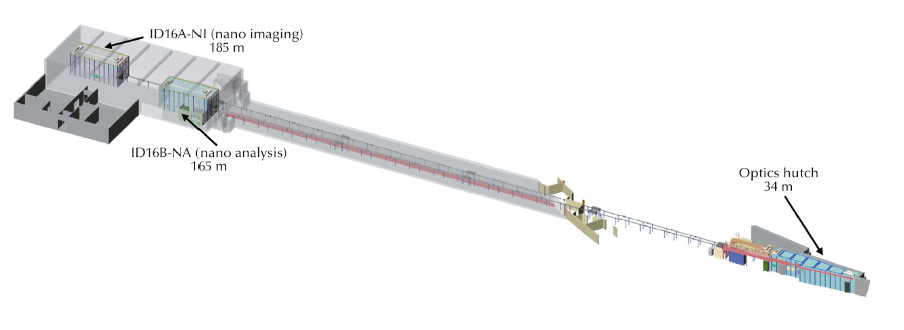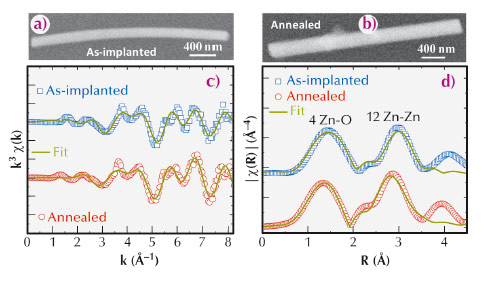X-ray imaging
The articles presented in this chapter illustrate the broad range of scientific topics covered by the X-ray imaging beamlines at the ESRF, from medicine and life science to palaeontology and historical artefacts. All the examples share a common property: the heterogeneity (and often complexity) of the samples. They usually differ in terms of size, composition and structure: from the 30 cm long burrow cast in the article by Fernandez et al. to 300 nm wide nanowires (Figure 8, below). The X-ray imaging beamlines offer our users a very wide range of accessible lateral resolution and corollary sample size, and an extended set of imaging and analytical tools.
 |
|
Fig. 7: Layout of upgrade beamlines ID16A and ID16B. |
Ultimate nanometric resolution will soon be accessible through the NINA project (nano-imaging and nano-analysis, ESRF Upgrade Programme UPBL4). NINA will provide two new beamlines, ID16A and ID16B (Figure 7), designed following the experience gained on the ID22 Nano-imaging End-station, which is now closed. It has been a very busy year for those involved in this flagship project: installation of the common optics hutch was completed in October, successful radiation tests of the experimental hutches were carried out in early November. Now our efforts are focused on the installation of the end-stations, with the aim of putting into operation the nano-analysis beamline ID16B for user experiments in Spring 2014. The Nano-imaging Beamline ID16A will be optimised for ultimate hard X-ray focusing of a beam with a large energy bandwidth (1%) at specific energies (17 keV or 33.6 keV). It will address problems in biology, biomedicine and nanotechnology using X-ray fluorescence microscopy and nanotomography. The kind of research that could benefit from beamline ID16A is illustrated by two highlight articles, the investigation of the subtissue metal distributions within Daphnia magna and the study of copper pathology in vulnerable brain regions in Parkinson’s disease. Cryogenic sample preservation, which is fundamental for such biological samples, will be available by the end of 2014. New coherent imaging techniques, such as near-field ptychography, will also be an interesting capability of the beamline. The article by Stockmar et al. in the chapter Enabling Technology illustrates this area of research. The main focus of the Nano-analysis Beamline ID16B is analytical capabilities exploiting a tuneable monochromatic nanobeam (spatial resolution 50 nm - 1 µm), in particular for X-ray absorption spectroscopy and X-ray diffraction. These techniques will be complemented by fluorescence nanoscopy and nanotomography. Different operation modes will be available (monochromatic and pink beam) over a wide and continuous energy range (5-65 keV). Flexibility in terms of sample environments, especially interesting for in situ and in operando analyses, will also be a feature of ID16B. The nano-XAS study performed by Chu et al. on single Co-implanted ZnO nanowires, illustrated in Figure 8, is a typical example of future research activities at ID16B. This study combines both the nanoscale resolution and the chemical information offered by a set of complementary X-ray techniques.
 |
|
Fig. 8: Nano-EXAFS study of as-implanted (a) and annealed (b) Co:ZnO nanowires. Data and best fit of Zn K-edge EXAFS oscillation functions k3χ(k) (c) and magnitude of the Fourier-transformed (d). The spectra reveal an elongation of the first two nearest interatomic distances for the as-implanted nanowire compared to the annealed one. It indicates an expansion of the lattice along the as-implanted nanowire. The similar interatomic distances between the annealed nanowire and bulk ZnO (1.95 ±0.02 and 3.23 ±0.02 Å) suggest a good recovery of the implantation-induced damage through a thermal annealing process (From Chu et al. [1]). |
At an intermediate submicrometric scale, the spectromicroscopy beamline ID21 also offers new instrumental capabilities, with the so-called “full-field XANES set-up”, which combines 2D imaging with spectroscopic characterisation. This instrument is very efficient for the large scale microspectroscopic study of concentrated elements, as illustrated in the article by Meirer et al. on the analysis of Fe speciation in ancient ceramics. The full-field XANES set-up complements well the scanning X-ray microscope that offers micro-spectroscopy in X-ray fluorescence mode for more diluted elements.
Finally, at the opposite end of the beam size scale, the paleontology facility project aims at improving X-ray coherent imaging capabilities for large samples. The diversity of the highlights related to paleontology reflects the intense activity of this community at the ESRF. Important instrumental developments are under way at ID17 and ID19 to improve simultaneously the field of view and the lateral resolution. A transfocator has already been installed in the ID19 optics hutch and a new monochromator will follow shortly. Further developments in optics and detectors are planned for 2014 to further increase the field of view, and more generally the versatility of the different imaging configurations, in particular, the capabilities in rapid in situ imaging.
M. Cotte
References
[1] M.H. Chu, G. Martínez-Criado, J. Segura-Ruiz, S. Geburt and C. Ronning, Appl. Phys. Lett. 103, 141911 (2013).



